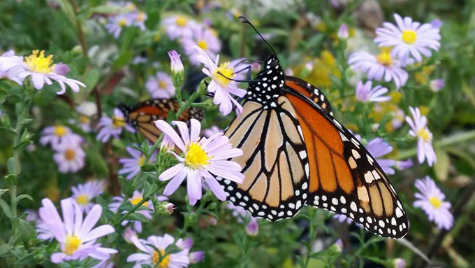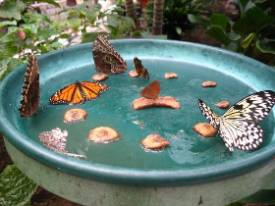Landscaping for Butterflies

The flash of a colorful butterfly and the buzz of a bumble bee traveling between flowers bring extra beauty and enjoyment to our gardens. Pollinators serve an important role in our ecosystem but they also bring beauty to our lives by simply watching them live and do their thing. A pollinator garden can easily become a focal point of any landscape. Planning your garden or landscape to include plants that attract and sustain butterflies, bees, and other beneficial insects can increase the populations of these desired insects and increase the diversity you can observe and enjoy. Let’s walk through planning a pollinator garden that can attract a variety of beneficial insects to your yard this year.
Location, location, location. One of the first steps to planning your  pollinator garden is to pick the location. The best location is one that receives as much light as possible. Butterflies and other pollinators are cold blooded and need sunshine to warm up their bodies. Butterflies in fact cannot fly unless their body temperatures is 86 degrees or warmer so they are most active when the sun shines. The other reason to have a location in full sun is that most of the plants that pollinators prefer require at least six hours of direct sunlight a day to perform best. Try to pick a location that is out of the harsh winds as much as possible. This helps both the plants and the butterflies survive and prevents damage to both.
pollinator garden is to pick the location. The best location is one that receives as much light as possible. Butterflies and other pollinators are cold blooded and need sunshine to warm up their bodies. Butterflies in fact cannot fly unless their body temperatures is 86 degrees or warmer so they are most active when the sun shines. The other reason to have a location in full sun is that most of the plants that pollinators prefer require at least six hours of direct sunlight a day to perform best. Try to pick a location that is out of the harsh winds as much as possible. This helps both the plants and the butterflies survive and prevents damage to both.
Pick your plants. When we think of plants for pollinators we typically think of the flowers the plants provide but it is important to provide food sources for all stages of a pollinators life cycle. Simply providing nectar sources for the adults is not enough to attract and keep pollinators in your back yard. You will need to also have host plants for the pollinator caterpillars or larval form to feed on. Many plants can pull double duty and serve both purposes but not all. If you want specific butterflies to come to your back yard, be sure to pick host plants that those butterflies specifically like. We all know that monarch caterpillars need milkweed but did you know that black swallowtails are the only ones who feed on dill while Zebra swallowtail caterpillars only feed on pawpaw trees. As you are choosing plants be sure to choose a mix of plants that have bloom times that cover the entire growing season to ensure there is a food source for the butterflies for the entire summer. Herbs are also attractive to many different pollinators and mixing them in with other plants can provide a pleasing aesthetic. When you are making your design place the plants in blocks rather than individually as the blocks of color are easier for the pollinators to see. There is a big push for using native plants in pollinator gardens and while that is a great idea, pollinators will also use non-native plants in addition to natives. Check out the attached list of plants by Johnson County Master Gardeners for ideas.
Provide the extras. While food sources are important for pollinators they aren’t the only items we should be incorporating into our pollinator garden. As was mentioned before, insects are cold blooded and need the sunlight to warm up so they can fly. Be sure to add areas such as stones or bricks that will be in the sun early in the day for the insects to bask on so they can warm up. These stones can easily to incorporated into any landscape and add some unique elements to your design. Don’t forget to provide a water source for the insects. Mud puddles are a wonderful and inexpensive option, but you can also use shallow dishes or birdbaths with rocks in them to give the insects a place to perch while they are drinking.
bricks that will be in the sun early in the day for the insects to bask on so they can warm up. These stones can easily to incorporated into any landscape and add some unique elements to your design. Don’t forget to provide a water source for the insects. Mud puddles are a wonderful and inexpensive option, but you can also use shallow dishes or birdbaths with rocks in them to give the insects a place to perch while they are drinking.
Planning a garden for pollinators doesn’t have to be rocket science but it can provide years of enjoyment for you and your family watching the butterflies, bees and other pollinators fly around your back yard. There are many resources available for helping to plan your garden. Check out some of those resources or if you live in Butler County check out the pollinator garden at the Ranger Station at the El Dorado State Park for some ideas of things you can do in your back yard. Be sure to check out the additional resources included with this publication.

Have questions? Contact our office where our Horticulture Extension Agent will assist you with questions.
Phone: (316) 321-9660
Email: callae@ksu.edu